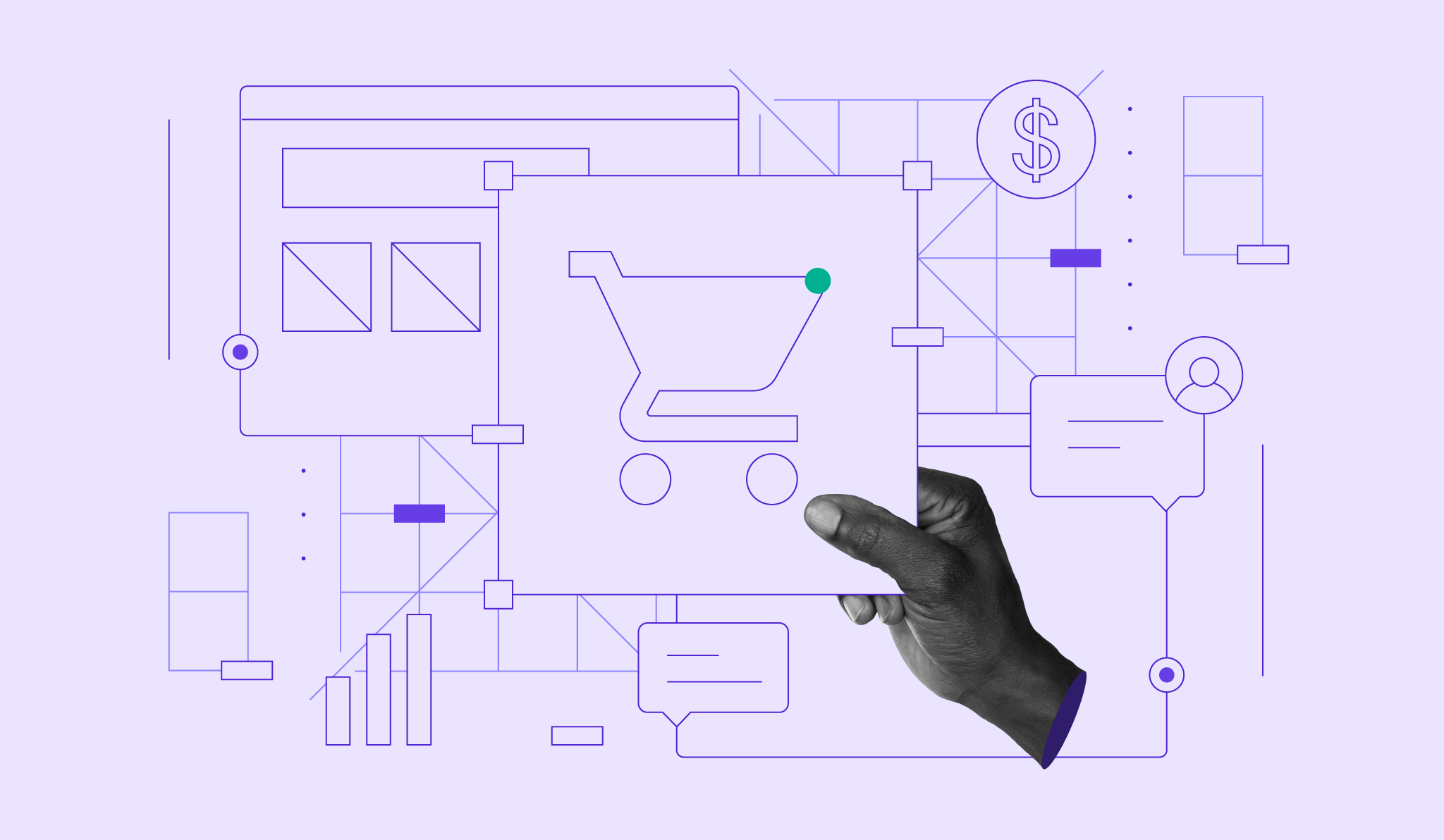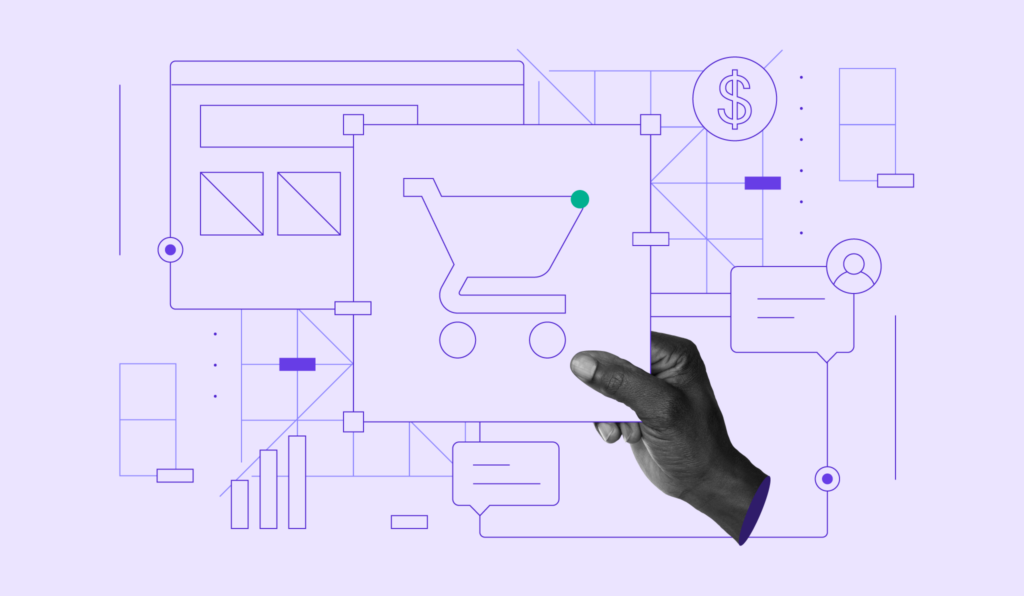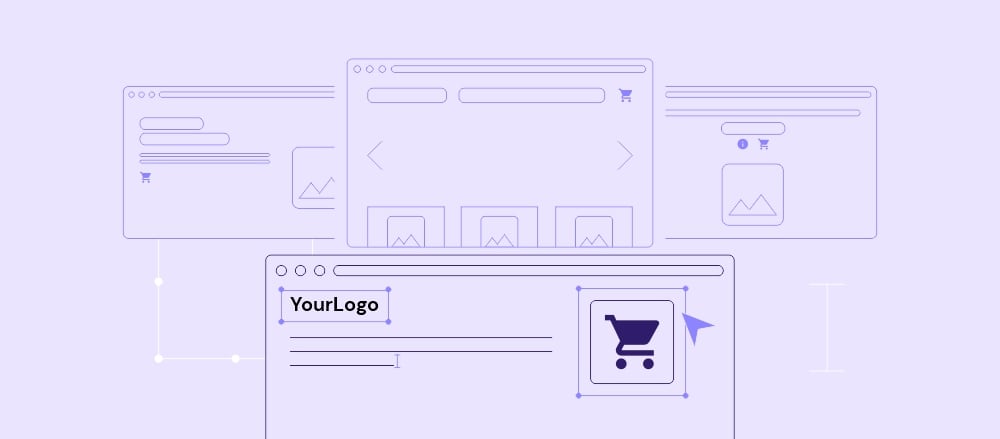Sell digital products online: a complete guide

Selling digital products is a great way to start an online business. Compared to physical products, they’re easier to create and manage since you don’t need storage space or worry about shipping and handling.
If you’re thinking about selling digital products, this article will cover what you need to know. This includes the types of products, how much you can make, and how to sell them. Our goal is to help you choose the right one so you can start immediately.
What is a digital product?
A digital product is any type of goods or services sold online that can be downloaded or accessed online. Digital products include ebooks, software, templates, courses, music, and more. We’ll go over different digital product examples later in this article.
Selling digital products is a great way to make money online because it can be a profitable and scalable passive income source. With no inventory to manage and low production costs, it’s an accessible option for creators and entrepreneurs.
Types of digital products to create and sell
These types of digital products cater to a wide range of skills and interests. Depending on your expertise and target audience, you can choose to create one or multiple types of products. Here are some popular options:
- Ebooks and PDFs. Sell educational products like guides, tutorials, or how-to resources. You can choose from niches you love, like traveling, cookies, or business.
- Online courses. Share pre-recorded video lessons, quizzes, and downloadable learning materials.
- Digital memberships. Sell digital subscriptions that offer exclusive content or extra perks to members paying regular fees.
- Music and art. Turn your creative hobby into income. Sell original songs, sound effects, and beats. For art, sell digital artwork like illustrations and designs for personal or commercial use.
- Online services. Provide services related to your expertise, such as website design, social media management, or virtual coaching.
- Templates. Sell pre-made templates, such as documents, designs, resumes, or presentations, that help increase your customers’ productivity.
- Software. Develop apps, plugins, or tools that solve specific problems or improve workflows for your target customers.
31 digital products to sell
Based on the above types of digital products, here are 31 digital goods for you to explore:
Ebooks and PDFs
The ebooks and PDF resources market is expected to grow to $22.76 billion by 2030. Considering this and the low production costs, choosing this type of digital product can be a highly profitable and scalable option.
You can sell ebooks on platforms like Amazon Kindle Direct Publishing or Payhip. For PDFs, you can use platforms like Gumroad or Etsy.
1. Ebooks and digital guides: Create ebooks or guides readers can refer to. These include travel guides, cooking recipes, personal development guides, and business tips. For ebooks, check out this list of the most profitable niches to inspire you.
2. Event planning checklist: Sell a standalone event checklist or bundle it with other checklists. The event options can include weddings, parties, or corporate events. Check out event planner examples on Etsy.

3. Customizable meal plans: Build a meal plan for different dietary preferences, like vegan, keto, or gluten-free. You can also create a plan based on the customer’s health profiles.
4. Personalized fitness plans: Create fitness plans tailored to specific goals, like weight loss, muscle gain, or improving endurance. These can include workout schedules, exercise guides, and nutritional advice. Personalized plans are also a great way to earn as a fitness influencer.
Online courses
Online courses are appealing to sell because they allow creators to share their expertise with a global audience. You can host them on platforms like Teachable, Udemy, or Thinkific, or sell directly from your own website.
5. Photography courses and tutorials: Share your knowledge through photography classes and tutorials. These can cover choosing the right cameras or introductory courses on lighting and composition. Sell your courses on a third-party platform or your own photography website.
6. Online fitness classes: Share fitness routines, workout plans, and tips for staying healthy. Create video lessons for specific goals like weight loss, strength training, or yoga, and add personalized workout schedules.
7. Cooking classes: Share cooking tips or meal prep ideas. From basic cooking to advanced baking, classes can suit all skill levels. For inspiration, check out the cooking courses available in Udemy.
8. Investment advice: Share tips related to the basics of investing, from personal finance management to bonds or mutual funds. These courses can include video lessons, downloadable resources, and practicable guides.
Pro Tip
Read our guide on selling online courses to help you get started. It also covers the best platforms and ways to promote your courses
Digital memberships
Digital memberships work because people are willing to pay for content. They usually provide more value than free content. Sell your memberships on platforms like Patreon, Kickstarter, Mighty Networks, or Instagram Subscriptions.
9. Exclusive video content: Create and publish exclusive videos complete with perks, like no ads, bonus episodes, or behind-the-scenes content. For example, True Crime Obsessed shares video content on Patreon, with membership plans starting at $5–$7/month.

10. Premium content: Share exclusive content, like workout routines or fashion advice, as part of a membership package. For example, influencers can sell premium content directly through Instagram Subscriptions.
11. Newsletter subscriptions: Create and sell subscriptions for regular newsletters containing exclusive content, members’ benefits, or curated content related to your niche.
12. Premium blogs and articles: Publish in-depth articles or blogs on platforms like Medium or Substack. This works well for wellness, finance, or tech niches, offering readers exclusive, high-value written content.
13. Podcast subscription: Offer exclusive podcast episodes or early access to your subscribers. You can release new content weekly or on a schedule that suits your audience’s needs. Check out the podcasts on Supercast for inspiration.

Music and art
These digital products are best for creative individuals passionate about making music and art. You can sell music tracks, sound effects, and custom beats on platforms like Bandcamp, BeatStars, Airbit, or Traktrain.
For stock photos, use platforms like Creative Market. Printable art, like posters or digital designs, works well on your own website or print-on-demand platforms like Printify.
14. Exclusive music tracks: Sell licensed music tracks as a small artist on platforms like Bandcamp. Share your original compositions with fans or creators who need unique audio for their projects.
15. Premium stock photos: Upload and sell high-quality stock photos on platforms like Creative Market. Check out our tips to sell photos online to guide you.
16. Printable art: Sell artwork or other printable media online, such as posters, illustrations, or graphic designs. You can upload the art on marketplaces or your own website.
17. Sound effects: Create sound effects for video editors, podcasters, or game developers, and sell them as individual files or bundles.
18. Custom music beats: Produce and sell custom beats for musicians or content creators. You can explore drum kits, samples, presets, and loops.
Online services
Offering online services is a great way to turn your skills into a profitable business. Whether it’s freelance work or specialized tasks, you can sell your services on platforms like Fiverr and Upwork, or directly through your own website.
19. Freelance services: Offer services based on your expertise, such as writing, graphic design, or social media management. Learn how to get started with our guide to starting a freelance business.
20. Custom logo designs: Create logos for businesses or individuals. Use tools like Canva or Adobe Illustrator to help.
21. Personalized trip itineraries: Plan unique travel experiences by creating custom itineraries tailored to your clients’ preferences, including activities, accommodations, and local tips.
Templates
Digital templates are popular because they’re easy to use and provide professional, reliable results. You can sell templates on platforms like Etsy, Creative Market, or your own website.
22. Contract and invoice templates: Create and sell templates to help freelancers send contracts and receive payments. These tools make it easy to send professional documents and streamline payment processes.
23. Website templates: Design customizable website templates for platforms like WordPress or Shopify. Check out Hamza Ehsan’s website to get started.
24. Customizable personal budget templates: Create simple budget tracking tools that help users organize their expenses, savings, and financial goals.
25. Business bookkeeping templates: Offer bookkeeping templates to help small businesses track income, expenses, and profits. These digital downloads are a practical solution for entrepreneurs managing their finances.
26. Virtual assistant templates: Create templates that help virtual assistants with their jobs. These can include selling client welcome packets and social media post templates. You can sell in bundles to make it more convenient for users.
Software
Developing software may require more technical knowledge, but it’s a highly rewarding digital product. With many learning resources and tools available, building software is more achievable than ever for motivated creators.
Sell your products on platforms like Flippa, Gumroad, CodeCanyon, or your own website to reach a wide audience.
27. Custom software solutions: Develop and sell software that addresses specific needs for businesses or individuals. Examples could be project management tools or inventory systems.
28. Website development: Design and develop websites for clients, catering to businesses, bloggers, or entrepreneurs. Learn how much to charge for a website to keep your rates competitive yet profitable. Check out Anna Franques’ portfolio to inspire you.

29. Apps: Build mobile or web apps designed for specific needs, like productivity, education, or entertainment. Apps are an excellent way to tap into a growing tech-savvy market.
30. Plugins: Develop plugins to extend the functionality of platforms like WordPress or Shopify. Examples include SEO tools, payment integrations, or advanced customization features.
31. Themes: Similar to plugins, you can start designing and selling website themes for platforms like WordPress.
Suggested reading
Learn how to use WordPress to help get you a step closer to developing plugins and themes you can sell.
How much can you make selling digital products?
In general, you can make around $1,000-2,000/month, but that also depends on the product and target audience. Successful digital product sales can earn $93,000 in revenue from selling on Etsy. Here’s how much profit each digital product can make:
- Ebooks and PDFs. Both items can generate different income levels. PDFs can earn you up to $1,000 in a month. Ebooks typically make $2–$5 per month, depending on pricing and platform fees. Experienced Ebook sellers with 6+ years of experience can earn up to $45,000 in that period of time.
- Online courses. Depending on the course’s subject, you can expect to earn $1,000–$10,000/month.
- Digital memberships. On average, creators can sell memberships and earn $12,000 in revenue.
- Music and art. Selling music, like custom beats, can earn you around $100–$1000/month. For art, you can expect to earn between $100–$2,000 depending on the price you set.
- Online services. Offering online services, much like freelancing, can earn you anywhere from $31,000–$275,000.
- Templates. Selling these digital downloads can earn you up to $2000/month and more.
- Software. Selling a website could earn $1,400, as proven by Peter Voica. Creating and selling WordPress themes might bring in $10,000. If you develop custom software solutions, you could make as much as $146,000/year.
Regardless of which product you choose, the final number/profit depends on how you price the products and where you sell them. Now let’s review the benefits of selling digital products.
Why sell digital products
- Earn passive income. Once created, digital products can be sold repeatedly without requiring much ongoing effort. This makes it a great side hustle you can do from home.
- Keep costs low. Since digital products don’t need physical materials, manufacturing, or storage, they’re inexpensive to produce and maintain.
- Skip inventory hassles. Compared to selling physical products, you don’t need to worry about managing stock and shipping products since everything is delivered digitally.
- High profit margin. Minimal production and delivery costs mean you can enjoy a greater share of the profits.
- Mobile commerce opportunity. With the rapid growth of mobile commerce, more people are purchasing digital downloads directly from their smartphones. This trend opens up a massive opportunity to reach a global audience and increase sales.
How to sell digital products
Selling digital products involves four key steps, from finding the right niche to promotion on relevant platforms. Let’s review them.
1. Find your niche
It’s important to choose a niche that aligns with both market demand and your passions. When you create something you enjoy, staying motivated and delivering value becomes easier.
Start by researching trends using tools like Google Trends or exploring popular products on Amazon Best Sellers, Etsy, or eBay. Doing so will help you identify gaps in the market and understand what’s currently in demand.
Additionally, analyze your audience by creating buyer personas. Consider their age, interests, and needs. Then, join online forums or social media groups to learn more about their challenges and preferences.
Finally, study your competitors to see what they offer and identify areas to stand out. Differentiating your digital product through better features, higher quality, or excellent customer service increases your chances of success.
2. Create high-quality digital products
Start creating your digital products by outlining the main features to add. Your digital products should be user-friendly and bring value to your audience.
For eBooks or courses, list key topics and subtopics. For software or apps, define features and how users will interact with them. Break your process into small, manageable steps for development and testing.
Next, use the right tools to help create your digital products. For example:
- Canva or Affinity Publisher for designing eBooks, guides, templates, and graphics.
- Final Cut Pro or Camtasia for producing videos or online courses.
- Cubase or Reaper for creating music or sound effects.
- Figma or Sketch for designing mobile or web apps.
- Procreate or Krita for creating digital artwork like illustrations and designs.
Before launching, test your product with a small audience to gather feedback. Use their input to improve the quality and make your product as valuable as possible.
3. Sell your products
Choosing the right platform to sell your digital products is crucial for success. You can opt for third-party platforms or your own online store, each offering unique benefits.
Third-party platforms like Shopify, Etsy, or Gumroad provide easy setup and access to a large customer base. These are great for beginners or those looking for quick exposure.

However, keep in mind that these platforms often charge transaction fees or commissions, which could reduce your overall profit. For example, Etsy charges a 6% fee, and Gumroad charges a 10%-30% fee for each sale.
If you want an alternative, consider selling on your website using a platform with no transaction fees – like Hostinger eCommerce Website Builder. Owning a website also gives you full control over product branding and profit margins while helping you build business credibility.
The builder is perfect for selling digital products in various formats, including YouTube videos. After a purchase, customers get a link to download their items.

You can create the website using AI or pre-made templates. Both options offer a quick way to set up and publish the website you need for selling your digital products.
For more details, check out the eight steps to making an online store using Hostinger eCommerce Website Builder.
4. Promote your digital products
Marketing your digital products effectively can drive traffic to your store and convert visitors into customers. Here’s how to get started:
- Content marketing: Create blog posts or videos related to your niche that provide value and promote your products. If you sell cooking recipes, make a YouTube video with a recipe demo and link back to your store – like Binging With Babish.
- Email marketing: Offer freebies like a sample chapter or discount codes in exchange for email sign-ups. Use automated emails to engage subscribers and follow up on purchases.
- SEO: Optimize your product pages with relevant keywords and ensure your site is fast and mobile-friendly to rank higher in search results.
- Influencer and affiliate marketing: Collaborate with influencers in your niche to promote your products. Set up an affiliate program to encourage others to earn commissions by sharing your store.
- Social media: Share engaging posts, behind-the-scenes content, and customer testimonials on platforms like Instagram or Pinterest. Promote by sharing links to your social media bio. Use tools like Stan, Podia, or Gumroad. For example, TikTok account alexonabudget is using Stan to share financial templates as digital products.

Conclusion
With 31 digital product ideas to explore, there’s something for everyone. Whether it’s ebooks, online courses, or templates, aligning the product with your talents, passions, and interests is key.
Choose the right platform to sell your creations, and you’ll be well on your way to building a profitable digital product business.
Follow the steps in our guide and start selling digital products today!
Sell digital products online FAQ
How do I price my digital products?
Evaluate your costs, set your desired profit margin, and understand your customers. Then, research your competitors and choose a pricing strategy. To learn more, check out our article on pricing a product.
Do I need technical knowledge to sell digital products?
Yes, but only minimal technical skills are required. Beginner-friendly tools like Canva or Gumroad simplify the process of creating and selling. Plus, tutorials and articles online can guide you every step of the way.
How do I deliver digital products to customers?
You can use platforms like Gumroad or Etsy. Another option is to use Stan, which is integrated with social media profiles for instant access to digital products. If you need a website, opt for Hostinger eCommerce Website Builder, which allows you to sell and deliver your digital products on one platform.
How do you use social media to sell digital products?
Promote the products by creating content around your journey and how your products help solve problems. Add a link to your profile bio to where you display your products – either on your website or third-party platforms.





Comments
January 14 2024
I have a hostinger website, I've just started.How do prevent theft of my digital artwork. I know that I should watermark my digital artwork.I'm new to hostinger.I just need some guidance in setting up my artwork with a watermark.This concerns me.
January 24 2024
Hi there! For a more detailed and personalized guidance, I recommend reaching out to our Customer Success Team. We will be happy to assist you further ?